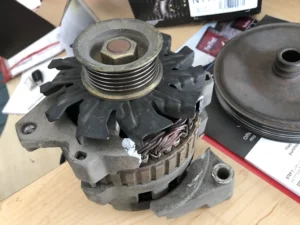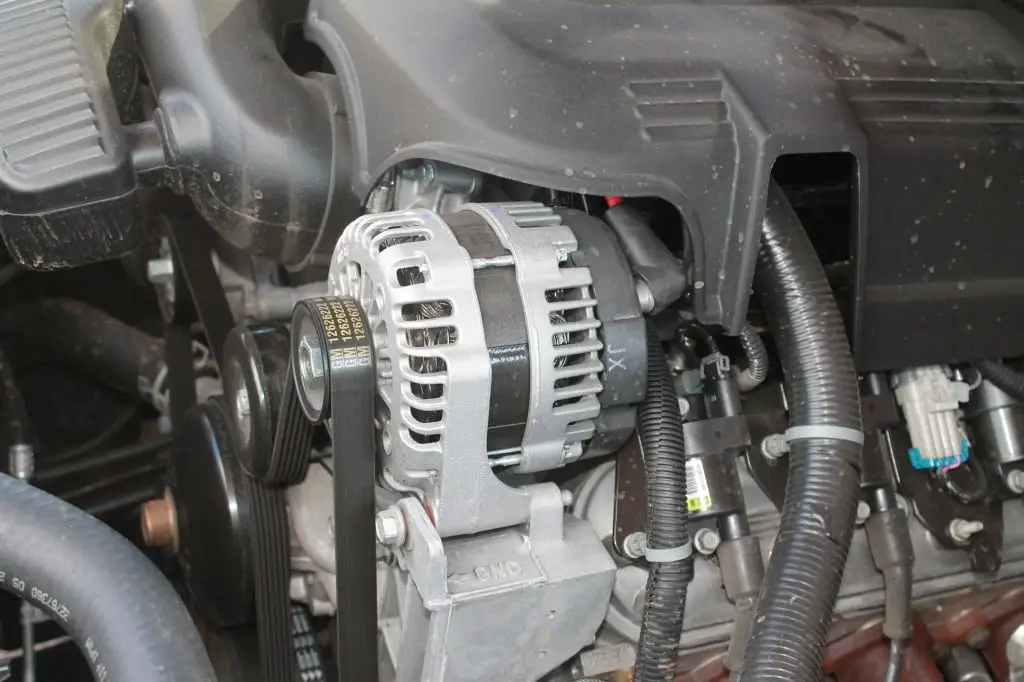Have you ever been cruising down the highway when your car’s electrical systems suddenly start acting up? The radio cuts out, the headlights dim, and you notice your battery voltage gauge dropping.
This common yet concerning issue – battery voltage drops while driving – can leave many drivers scratching their heads. But don’t worry! In this comprehensive guide, we’ll explore why this happens, how to fix it, and steps to prevent future problems. So buckle up and let’s dive into the world of car electrical systems!
Why Does Battery Voltage Drop While Driving?
Battery voltage drops while driving because the car’s electrical system uses more power than the alternator. This causes the battery to discharge, leading to a drop in voltage. Several factors can contribute to this issue:
- High electrical load from accessories
- Faulty alternator
- Weak or old battery
- Loose or corroded connections
- Extreme temperatures
Let’s examine each of these causes in more detail to understand better why your battery voltage might be dropping as you drive.
1. High Electrical Load
Your car’s electrical system powers numerous components, from essential systems like the engine control unit and fuel injection to comfort features like the radio and air conditioning. When multiple high-draw accessories are used simultaneously, it can put a strain on the electrical system.
For example, imagine you’re driving at night with your headlights on high beam, the heater blasting, windshield wipers going, and the stereo cranked up. All these devices together draw a significant amount of power.
If the alternator can’t keep up with this demand, it will start pulling power from the battery, causing the voltage to drop.

2. Faulty Alternator
The alternator is like a mini power plant for your car. It’s responsible for charging the battery and powering the electrical systems while the engine is running. If the alternator isn’t working correctly, it won’t be able to generate enough electricity to meet the car’s needs.
Signs of a failing alternator include:
- Dimming or flickering lights
- Strange noises from the engine bay
- Battery warning light on the dashboard
- Electrical systems working intermittently
A faulty alternator can cause battery voltage to drop while driving because it’s not replenishing the battery’s charge as quickly as it’s being used up.

3. Weak or Old Battery
Just like us humans, car batteries don’t last forever. As a battery ages, its ability to hold a charge diminishes. An old or weak battery might not have enough capacity to handle the electrical demands of your vehicle, especially during long drives or when using multiple accessories.
Typically, car batteries last about 3-5 years, depending on usage and environmental conditions. If your battery is nearing the end of its lifespan, you might notice:
- Slow engine cranking when starting
- Needing to jump-start the car frequently
- Swollen battery case
- Low fluid levels (in non-sealed batteries)
4. Loose or Corroded Connections
Sometimes, the problem isn’t with the battery or alternator themselves, but with how they’re connected to the car’s electrical system. Loose or corroded battery terminals can increase electrical resistance, making it harder for power to flow efficiently.
Corrosion often appears as a white, green, or blue powdery substance on the battery terminals. This buildup can act like an insulator, preventing proper electrical contact. Similarly, loose connections can cause intermittent power supply issues, leading to voltage drops while driving.

5. Extreme Temperatures
Both very hot and very cold temperatures can affect your car’s battery performance. In extreme heat, the battery’s internal chemical reactions speed up, potentially causing it to overcharge and reducing its lifespan.
Cold temperatures, on the other hand, slow down these reactions and increase the battery’s internal resistance.
These temperature effects can make your battery less efficient, causing it to struggle to maintain proper voltage, especially when faced with high electrical demands while driving.
How to Diagnose Battery Voltage Drops While Driving
Now that we understand the potential causes, let’s look at how you can diagnose the issue:
- Check the battery voltage: Use a multimeter to measure the battery voltage with the engine off and then running. A healthy battery should read around 12.6 volts when off and 13.7 to 14.7 volts when the engine is running.
- Inspect the battery: Look for signs of corrosion, damage, or swelling. Check the fluid levels if it’s not a sealed battery.
- Test the alternator: With the engine running, disconnect the negative battery terminal. If the engine dies immediately, the alternator might be faulty.
- Check the drive belt: A loose or worn drive belt can prevent the alternator from charging properly.
- Look for parasitic drains: Use an ammeter to check for any unusual current draws when the car is off.
- Perform a load test: This can help determine if the battery can hold a charge and deliver the necessary power under load.
Remember, if you’re not comfortable performing these tests yourself, it’s always best to consult a professional mechanic.
Solutions for Battery Voltage Drops While Driving
Once you’ve identified the cause of your battery voltage drops, here are some solutions to consider:
- Replace the battery: If your battery is old or weak, replacing it with a new one can solve many voltage issues.
- Clean and tighten connections: Remove any corrosion from the battery terminals and ensure all connections are tight.
- Repair or replace the alternator: If the alternator is faulty, it will need to be repaired or replaced to ensure proper charging.
- Adjust driving habits: Limit the use of high-draw accessories, especially when idling or in stop-and-go traffic.
- Upgrade your electrical system: For vehicles with high electrical demands, consider upgrading to a higher output alternator or adding a second battery.
- Address parasitic drains: If you’ve identified any unusual power draws when the car is off, have them repaired to prevent battery drain.
Preventing Future Battery Voltage Drops
Prevention is always better than cure. Here are some tips to help prevent battery voltage drops while driving:
- Regular maintenance: Have your car’s electrical system checked regularly as part of your routine maintenance.
- Keep the battery clean: Periodically clean the battery terminals to prevent corrosion buildup.
- Limit short trips: Short trips don’t allow the alternator enough time to fully recharge the battery. Try to combine errands into longer trips when possible.
- Use a battery maintainer: If your car sits for long periods, consider using a battery maintainer to keep it charged.
- Be mindful of electrical usage: While modern cars can handle multiple accessories, be aware of how much you’re using, especially when idling or in heavy traffic.
- Check your alternator belt: Ensure the belt is in good condition and properly tensioned.
- Protect from extreme temperatures: If possible, park in a garage or shaded area to protect your battery from temperature extremes.
Understanding Your Car’s Electrical System
To truly grasp why battery voltage drops while driving, it’s helpful to understand how your car’s electrical system works. Let’s break it down into simple terms:
The Battery
Think of your car battery as a big rechargeable AA battery. It stores electrical energy in chemical form and releases it as needed. The battery has two main jobs:
- Provide the initial burst of power to start the engine
- Act as a buffer to smooth out voltage fluctuations in the electrical system
The Alternator
The alternator is like a miniature power plant. Once the engine is running, the alternator takes over powering the car’s electrical systems and recharging the battery. It’s driven by a belt connected to the engine.
The Voltage Regulator
This component ensures that the alternator produces the right amount of voltage. Too little, and the battery won’t charge properly. Too much, and it could damage the electrical components.
Electrical Consumers
These are all the devices in your car that use electricity – from essential systems like fuel injection and ignition to comfort features like the radio and air conditioning.
When you’re driving, the alternator is constantly working to produce enough electricity to power all these systems and charge the battery. If the demand exceeds what the alternator can produce, or if any part of this system isn’t working correctly, you may experience battery voltage drops while driving.
Frequently Asked Questions
Let’s address some common questions about this issue:
Why does my voltage drop when in the drive?
When you put your car in drive, several electrical systems activate, increasing the load on the alternator. If the alternator can’t keep up with this increased demand, you may see a voltage drop. This is especially noticeable if you have a weak battery or faulty alternator.
Why is my battery voltage low while driving?
Low battery voltage while driving usually indicates that the alternator isn’t charging the battery properly. This could be due to a faulty alternator, loose connections, or a problem with the voltage regulator.
It’s also possible that the electrical demand is simply exceeding what the alternator can provide.
What causes the battery gauge to drop while driving?
A dropping battery gauge while driving can be caused by:
- A failing alternator
- Loose or corroded battery connections
- A weak or old battery
- Excessive electrical load from accessories
- Problems with the voltage regulator
Why is the battery voltage lower when the car is running?
Normally, the battery voltage should be higher when the car is running, as the alternator should be charging the battery. If the voltage is lower when running, it likely indicates a problem with the charging system, most commonly a faulty alternator.
When to Seek Professional Help
While understanding and diagnosing battery voltage issues can be empowering, there are times when it’s best to seek professional help:
- If you’re not comfortable working with electrical systems
- When diagnostic tests indicate a problem but you’re unsure how to fix it
- If you’ve tried basic solutions but the problem persists
- When dealing with hybrid or electric vehicles, which have more complex electrical systems
Remember, modern cars have sophisticated electrical systems, and improper repairs can lead to more serious (and expensive) problems down the road.
Conclusion
Battery voltage drops while driving can be a frustrating and potentially dangerous issue. By understanding the causes, knowing how to diagnose the problem, and taking preventive measures, you can keep your car’s electrical system running smoothly and avoid being stranded with a dead battery.
Remember, your car’s electrical system is a complex network of components working together. Regular maintenance, being mindful of your electrical usage, and addressing issues promptly can go a long way in preventing battery voltage drops and other electrical problems.
So the next time you notice your headlights dimming or your radio cutting out while driving, you’ll have the knowledge to understand what’s happening and the steps to take. Happy (and electrically stable) driving!

